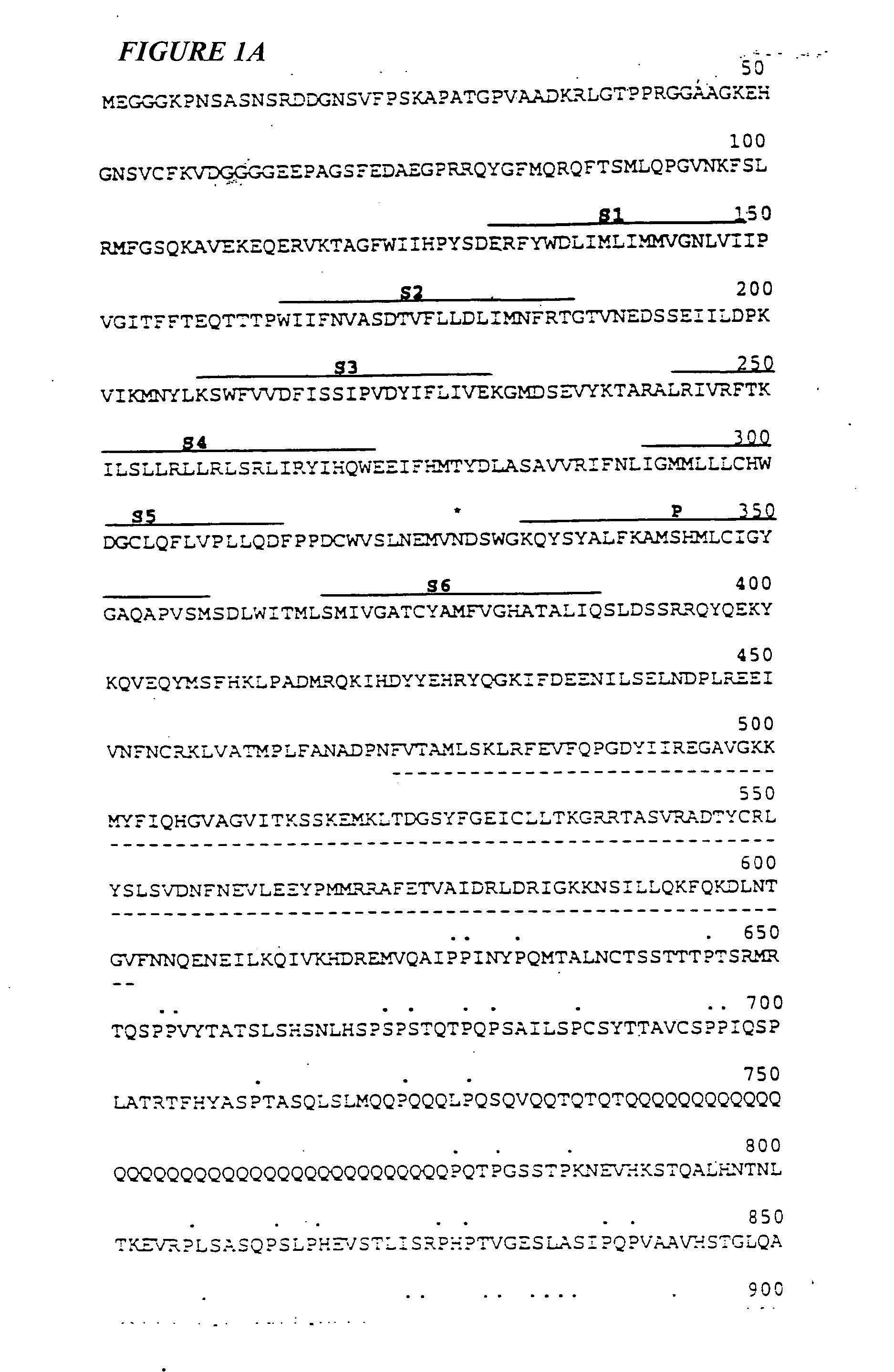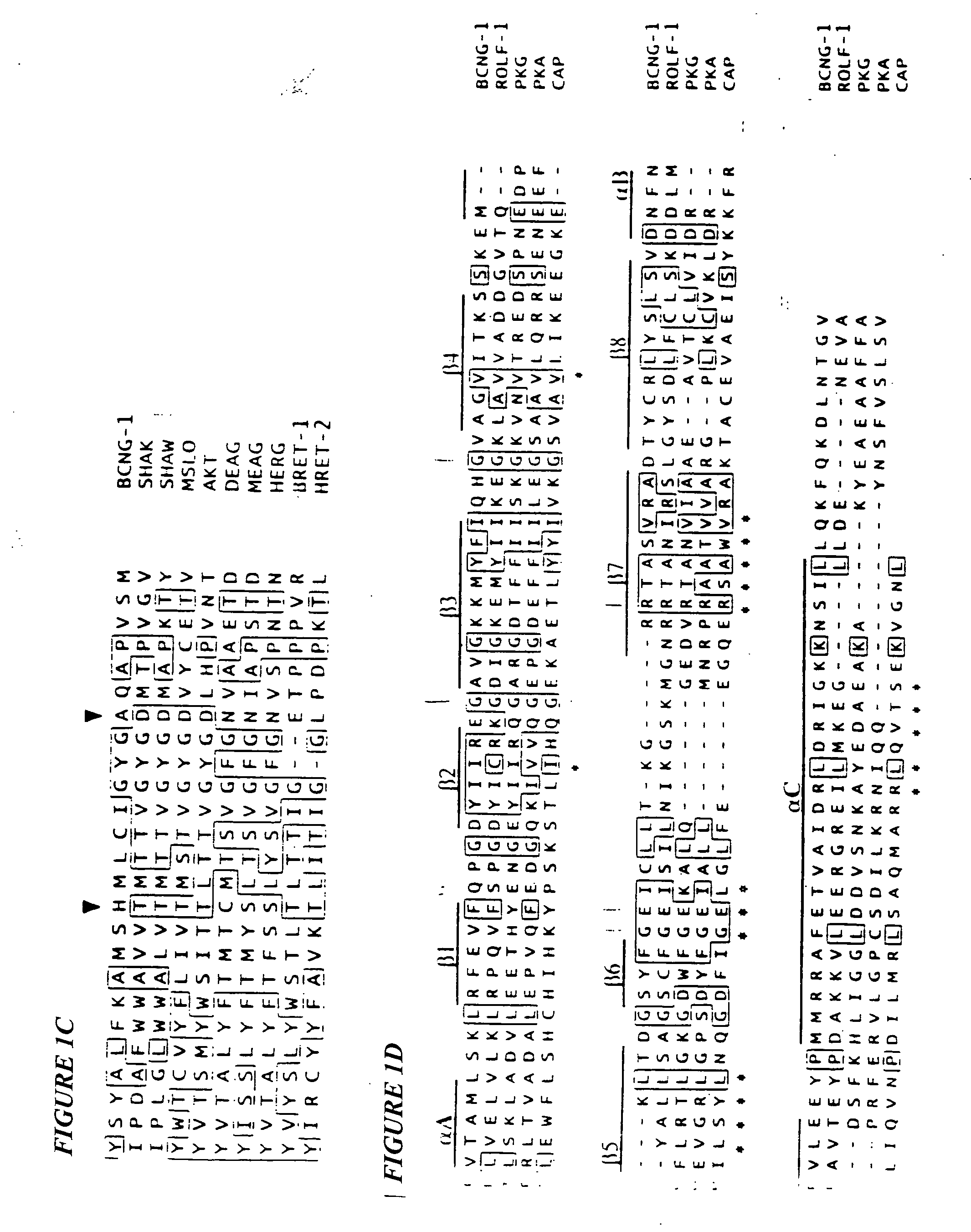Pacemaker ion channel proteins and uses thereof
- Summary
- Abstract
- Description
- Claims
- Application Information
AI Technical Summary
Benefits of technology
Problems solved by technology
Method used
Image
Examples
example 1
Interactive Cloning with the SH3 Domain of N-Src Identifies a New Brain-Specific Ion Channel Protein, with Homology to Cyclic Nucleotide-Gated Channels
[0063] By screening for molecules that interact with the neuronal form of Src tyrosine kinase a novel cDNA was isolated that appears to represent a new class of ion channels. The encoded polypeptide, mBCNG-1, is distantly related to proteins in the family of the cyclic nucleotide-gated channels and the voltage-gated channels, Eag and H-erg. mBCNG-1 is expressed exclusively in the brain as a glycosylated protein of approximately 132 kD. Immunohistochemical analysis indicates that mBCNG-1 is preferentially expressed in specific subsets of neurons in the neocortex, hippocampus and cerebellum, in particular pyramidal neurons and basket cells. Within individual neurons, the BCNG-1 protein is localized to either the dendrites or the axon terminals depending on the cell type.
[0064] Southern blot analysis shows that several other BCNG-relat...
example 2
Initial Cloning and Description of the Mouse BCNG Gene Family
[0108] The original sequence in the BCNG family (mBCNG-1) was isolated from a mouse brain cDNA library using yeast two-hybrid interaction cloning with the n-Src tyrosine kinase as a bait as described in Example 1. The DNA and amino acid sequences of this protein are Seq. ID. No.:1 and Seq. ID. No.:2 respectively. Clones comprising two additional genes (mBCNG-2 and mBCNG-3) have been isolated. The DNA and amino acid sequences of mBCNG-2 are Seq. ID. No.:5 and Seq. ID. No.: 6 respectively. The DNA and amino acid sequences of mBCNG-3 are Seq. ID. No.:9 and Seq. ID. No.:10 respectively. A more detailed description of the methods used to identify the sequences reported here are given in the methods section below.
[0109] All of the identified sequences contain the motifs of a voltage gated potassium channel (six transmembrane spanning domains, including a highly basic S4 domain, and a pore region) as well as a distinct cyclic n...
example 3
Physiological and pharmacological significance of mouse and human BCNG channel genes.
[0142] Introduction
[0143] The unique structural features and the tissue distribution of the predicted proteins of the BCNG gene family suggests that they may encode the pacemaker current (variously called Ih, If or Iq) of the heart and brain. Even if the BCNG gene family does not encode the pacemaker current it is likely to be a component of other—perhaps unidentified—ionic current(s) that are important in cardiac renal, hepatic and central nervous system function. Irrespective of the identity of the current(s) that the BCNG proteins contribute to, the unique structural features of the predicted BCNG proteins (the unusual ion conducting pore (P) domain, the highly conserved cyclic nucleotide binding (cnbs) site and the highly conserved and highly charged S4 voltage sensor) indicate that they will be susceptible to multiple drug intervention strategies that target the pore, the cyclic nucleotide bi...
PUM
| Property | Measurement | Unit |
|---|---|---|
| Size | aaaaa | aaaaa |
| Protein activity | aaaaa | aaaaa |
| Fluorescence | aaaaa | aaaaa |
Abstract
Description
Claims
Application Information
 Login to View More
Login to View More - R&D
- Intellectual Property
- Life Sciences
- Materials
- Tech Scout
- Unparalleled Data Quality
- Higher Quality Content
- 60% Fewer Hallucinations
Browse by: Latest US Patents, China's latest patents, Technical Efficacy Thesaurus, Application Domain, Technology Topic, Popular Technical Reports.
© 2025 PatSnap. All rights reserved.Legal|Privacy policy|Modern Slavery Act Transparency Statement|Sitemap|About US| Contact US: help@patsnap.com



